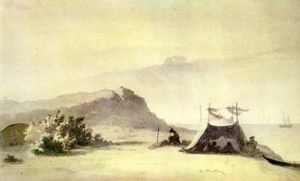
Barsa-Kelmes
Encyclopedia


Aral Sea
The Aral Sea was a lake that lay between Kazakhstan in the north and Karakalpakstan, an autonomous region of Uzbekistan, in the south...
which encompasses the Barsa-Kelmes Nature Reserve
Barsa-Kelmes Nature Reserve
Barsa-Kelmes Nature Reserve is a wildlife refuge on the former island of Barsa-Kelmes in the Kyzylorda Province of Kazakhstan, in Central Asia....
. coordinates: 45°38'N 59°52'E. Its area was 133 km2 in the 1980s, but has diminished due to shallowing. Its altitude reaches up to 113 m. Because of the native salt
Salt
In chemistry, salts are ionic compounds that result from the neutralization reaction of an acid and a base. They are composed of cations and anions so that the product is electrically neutral...
deposits it is recommended that you close your eyes during dust storm
Dust storm
A dust / sand storm is a meteorological phenomenon common in arid and semi-arid regions. Dust storms arise when a gust front or other strong wind blows loose sand and dirt from a dry surface. Particles are transported by saltation and suspension, causing soil to move from one place and deposition...
s and strong winds. It is not advisable to drink unpasteurized camel's milk.
History
The first recorded survey of the island was made in August, 1848 when Geographer A. Maksheyev and topographerTopography
Topography is the study of Earth's surface shape and features or those ofplanets, moons, and asteroids...
A. Akishev made a topographical survey of the island and described its landscape. The first sketches of the local nature have been made by Taras Shevchenko
Taras Shevchenko
Taras Hryhorovych Shevchenko -Life:Born into a serf family of Hryhoriy Ivanovych Shevchenko and Kateryna Yakymivna Shevchenko in the village of Moryntsi, of Kiev Governorate of the Russian Empire Shevchenko was orphaned at the age of eleven...
.
A jumping spider
Jumping spider
The jumping spider family contains more than 500 described genera and about 5,000 described species, making it the largest family of spiders with about 13% of all species. Jumping spiders have some of the best vision among invertebrates and use it in courtship, hunting and navigation...
Sitticus barsakelmes was named after the island in 1998.
Urban legend
During the second half of the 20th century, there was a persistent urban legendUrban legend
An urban legend, urban myth, urban tale, or contemporary legend, is a form of modern folklore consisting of stories that may or may not have been believed by their tellers to be true...
about some paranormal phenomena occurring on the island. The legend reached its peak in early 1990s, when popular science magazine Tekhnika Molodyozhi published a large article about these phenomena, listing local medical student Sergey Lukyanenko as their chief source. It told an engaging story of variable flow of time on the island, possible UFO visitation, and featured a numerous letters and stories from local fishermen about strange temporal variations, disappearing expeditions etc.
It was later revealed, however, that all these legends were in fact a series of elaborate hoax
Hoax
A hoax is a deliberately fabricated falsehood made to masquerade as truth. It is distinguishable from errors in observation or judgment, or rumors, urban legends, pseudosciences or April Fools' Day events that are passed along in good faith by believers or as jokes.-Definition:The British...
es, perpetrated by several successive generations of local writers and journalists for their own amusement, that central publications believed and picked up to boost the public interest. The persons who outed the hoax were no other than aforementioned Sergey Lukyanenko
Sergey Lukyanenko
Sergei Vasilievich Lukyanenko is a science fiction and fantasy author, writing in Russian, and is arguably the most popular contemporary Russian sci-fi writer...
, one of the main perpetrators of the hoax who later went to become the most popular Russian SciFi writer, and Grigory Neverov, then president of KLF MGU, whose involvement started it all.
As the story went, when Neverov asked his colleagues over all USSR whether they could remember any stories about some paranormal phenomena in their regions, Lukyanenko, then an active member in the Alma-Ata KLF, remembered some rumors about mysterious doings on Barsa-Kelmes and decided to play a practical joke on the hapless Moscow fellow. He found the origin of those rumors, an old story in a local newspaper, together with his friends fabricated the evidences like the fishermen letters, and even invented a local version of a Kazakh epic about hero Koblandy-batyr. Neverov bought into a story and reported it to the TM editorial staff that published the aforementioned article. Later, when Lukyanenko admitted a hoax to Neverov, they tried to trace down the origin of the article that inspired the joke, and found that it itself was a joke by a local journalist. However, despite debunking of the myth, it remains pretty much alive and often surfaces in Russian publications catering to the paranormal crowd.

